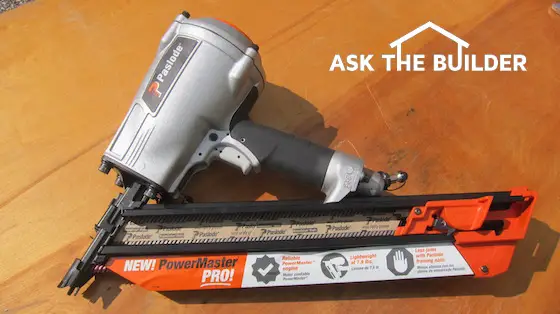Pneumatic Nailing Tools

Pneumatic Nailer
DEAR TIM: I am on the fence deciding which remodeling contractor to choose. The one contractor uses pneumatic nailers for just about every task. The other company uses traditional hand nailing for all tasks. Is there a difference between the two methods? Are the air driven nails inferior? Is there an advantage to using pneumatic nailers? How do you drive your nails? A. R.
DEAR A. R.: I drive my nails to the jobsite in my truck. Ha Ha! Just kidding! To be honest, I have a wide assortment of pneumatic nailers. Several have served me without a breakdown for more than eight years. I still use my hammer as well for certain rough framing tasks, however.
The use of pneumatic nailers has grown significantly in both the new home construction and remodeling industries. The reasons are simple. Pneumatic nailers increase productivity and offer superior fastener withdrawal resistance when compared to certain hand driven nails. An average home may use up to 70,000 nails. Nail guns don't get tired like arms do.
Major tool manufacturers offer an extensive assortment of nail guns. Yes, I said guns. Pneumatic nailers fire sharp objects at high speeds. If used improperly, they can cause serious injury.
My collection of pneumatic nailers includes a framing tool that can shoot a three and one-half inch nail into a piece of solid oak. I also have a nail gun that can shoot a small one half inch brad for fine trim or cabinet work. My favorite gun is one that fires two inch finish nails into interior trim lumber.
Nails driven with pneumatic nailers are tough to remove. The nails are coated with a resin that performs two primary functions. The resin glues one nail to another much like a strip of common staples. When the nail gun fires, friction is produced as the nail enters the wood. The resulting heat melts the resin. The liquid resin acts as a lubricant. Within seconds the resin becomes solid once again. The nail is actually glued into the wood!
If you choose the remodeler who hammers everything by hand, your interior trim may have an occasional beauty mark where a hammer kisses your wood trim. Most customers find these dents objectionable. A nail set may also slip off the nail head and mar the trim. Pneumatic nailers, when adjusted properly, will not create blemishes. In fact, they drive and countersink the nail in one rapid motion.
There are some slight disadvantages when using these fine tools. For example, when nailing roof or flooring plywood it is virtually impossible to tell if a nail misses a joist or roof truss. You need to visually check the underside of the plywood to make sure each nail is buried in wood. Also, the electrogalvanized coating on exterior nails does not offer the same level of protection as a twice dipped hot galvanized nail. If you must use a pneumatic nailer for outside work, use stainless steel nails.